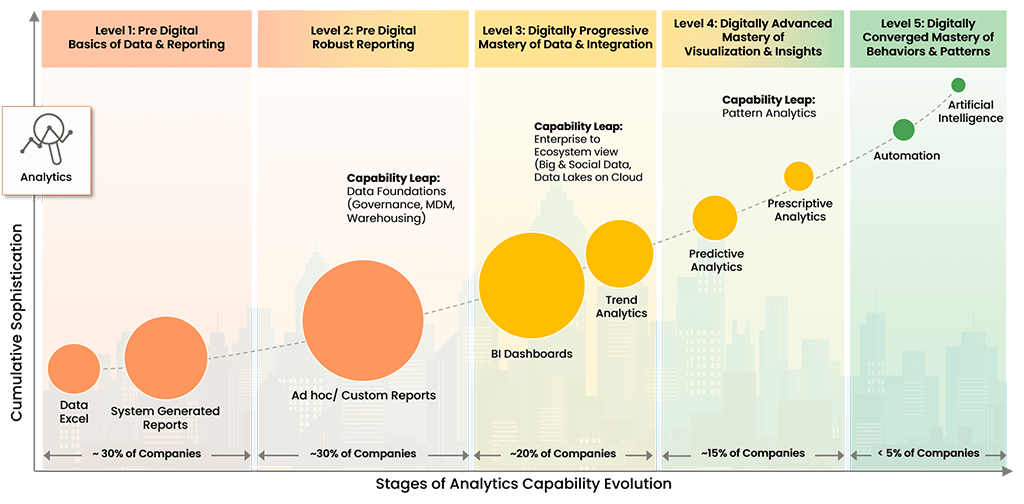The State of Digitalization in the Telecom Industry
Over 70% of telecom companies are in various stages of cloud adoption for their infra, analytics, and business applications, following the evolutionary path of Digital Champions. Except for IoT on the cloud, a large cross-section of telecom companies are in the value realization and implementation phases of cloud migration. Telecom now recognizes the cloud as a significant factor in transformation. It shows a greater willingness to take risks by migrating infrastructure, analytics, and business applications to cloud.
30% of telecom companies are migrating to the cloud for analytics. Another 41% of telecom companies are in the planning stages and are laying down the building blocks to cloud migration, such as moving data and deploying MDM and governance frameworks. Shrinking margins, coupled with the commoditization of services, are the primary drivers for telecom companies to move infra to the cloud. 12% of organizations report they are in the value realization phase, and another 35% of companies state that they are in the implementation phase.
In terms of migrating business applications to the cloud, one-fifth of the telecom companies are in the value realization phase, while another 23% are in the implementation phase. IoT on the cloud is poised to be the next harbinger of disruption and business transformation in telecom. It is the next sign because service providers seek to collect as much data as possible from towers, network equipment, sensors, and other resources to derive operation insight. 50% of the companies in telecom are in various stages of preparing, planning, and implementing cloud migration of IoT applications and analytics.
Only 7% of Companies Are Delivering on Their Transformational Initiatives
Our research has shown that 30% of companies will fail to survive this decade due to an inability to evolve digitally. To address this negative trend, we have developed the Digital Enterprise Evolution Model™ (DEEM).
Digital Enterprise Evolution Model™

Copyright © 2022 Trianz
DEEM allows our clients to recognize digital evolution patterns, implement benchmarking and prioritization strategies, and initiate application management protocols to satisfy stakeholder and market requirements.
Securing Telecom’s Future
Security threats require planning and preparation. Only 33% of telecom companies report including data security in their 2-year plan. Given a much higher level of cloud adoption or digitalization, 91% of Digital Champions are focused on data security while investing across the board.
Digital Champions focus on application defense using AI the most, with 37% of them ranking this as their top priority, followed by a strong focus on self-defending networks), and anomaly detection software coming in third (23% choosing this as their top priority).
Telecom companies rank using machine learning defense applications as their main priority when it comes to security technologies (43% ranking it as highest priority), followed by the usage of AI (23%) and self-defending networks (17%). The focus on AI-based application defense shows that the foundation layer of aggregation and parsing is already in place, making the next layer of AI-based defense and self-defending networks possible.
Training Is Essential for Telecom Long-Term
Telecom companies need to close the training gap to ensure seamless day-to-day functioning of digitalized business operations. Talent training and readiness are directly correlated with the effectiveness of digital transformation programs in all industries. Most organizations do not invest enough in role-based training on digitalizing functional operations and technology or communicating with various stakeholders.
The correlation between the scale of training investments and the effectiveness is crystal clear, which is why Digital Champions have invested heavily in role-based training and certifications. Investing in training helps in accelerating the R&D cycle, learning from feedback, and continuous improvement.
A well-trained workforce continuously learns, and thus, sets up each iteration of transformation for higher success. While it is good news that only 5% of companies in all industries report an inadequately trained workforce, there is ample opportunity for telecom to close the gap by better meeting the needs of an evolving workforce.
Experience the Trianz Difference
Trianz enables digital transformations through effective strategies and excellence in execution. Collaborating with business and technology leaders, we help formulate and execute operational strategies to achieve intended business outcomes by bringing the best of consulting, technology experiences and execution models.
Powered by knowledge, research, and perspectives, we enable clients to transform their business ecosystems and achieve superior performance by leveraging infrastructure, cloud, analytics, digital and security paradigms. Reach out to get in touch or learn more.


















